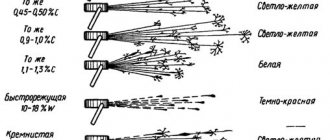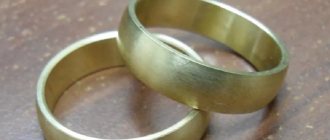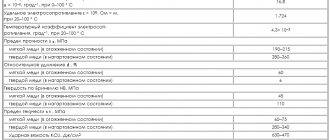Before you find out which element from the periodic table is awarded the title of “the most ductile metal,” you need to clearly understand what ductility is. This is one of the physical properties associated with the structure of the metal.
Plasticity is the ability to take on a new shape without causing ionic bonds to break. In practice, the result of plasticity is good malleability, due to which metals can be used in industry, medicine, electrical engineering and households. Of the 126 elements in the periodic table, gold is recognized as the most ductile metal. Thanks to today's technologies, it can be pulled out into the thinnest thread, which will not be visible to the human eye.
Which is better titanium or tungsten?
Titanium is very strong and hard and has a much lower density. Tungsten is slightly magnetic and slightly electrically conductive. Titanium is non-magnetic and less electrically conductive. Tungsten is not corrosion resistant in seawater like titanium and is not a photocatalyst like titanium.
Interesting materials:
How to leave a complaint to the post office bank? How is the mechanism of muscle contraction carried out? How is the list sorted? How to lighten denim? How to free up space in cloud storage? How to free up memory on Samsung j5? How was Stalingrad liberated? How to bleach yellow soles from white soles? How to bleach plastic dishes? How to thank a person in your own words?
Metal properties
Why do jewelry makers and repairers put gold first? First of all, this is due to its excellent ductility: from 1 gram of metal, a wire up to 3 kilometers long can be drawn, gold ingots are forged into sheets, the thickness of which is measured in ten thousandths of a millimeter. The domes of temples are covered with this gold; it is called leaf. It looks quite interesting: when exposed to light it gives a blue-green tint.
Pure gold can dissolve in aqua regia. This is the name given to a mixture of two concentrated acids: nitric and hydrochloric. The most ductile metal in the table is number 79, melting point is 1064 ° C, density is 19.32 g/cm3. In terms of thermal conductivity and electrical resistance, gold is second only to silver and copper.
Gold in its pure form is too soft, so jewelry is usually made from alloys. Most often, silver or copper is added to gold. Have you ever wondered what “test” means on jewelry? This is the pure gold content in parts per thousand. 999 purity is considered pure gold.
Definition of plasticity
From the Greek Πλαστική (“sculpting”, “modelling”) comes the word “plasticity”, which gave the root to others associated with changing the shape of a solid body. Plasticity is the property of a solid body to change shape and size and maintain residual deformation after the cessation of external forces without changing volume or compromising integrity.
For metals, this is one of the most important characteristics that allows them to be used in practice. Without the ability to shape metal blanks into the desired shape, it would be impossible to create even the simplest household items. Gold is the most ductile metal, and products made from it are an example of the shape that can be given to a fairly pliable material by forging, pressing, rolling, drawing, drawing, etc. The opposite property of the material is fragility.
Plasticity test
The ductility characteristics of metals are usually determined by static tests. The most revealing is the tensile test. To find out which metal is the most ductile, it is necessary to subject samples of the same size to this effect under similar temperature conditions. The amount of deformation that a metal sample can withstand before failure is an objective indicator of ductility.
The numerical expression of the tensile test result is two main coefficients. Relative elongation is the percentage ratio of the increased length of the sample after rupture caused by deformation to the original one. The most ductile metal - gold - has an indicator of 65%. For comparison: for iron – 40-50, for aluminum – 30-40.
The second indicator of plasticity is the relative narrowing of the cross section of the sample. For gold, the initial cross-section of the sample is 90% larger than what it had before breaking. For aluminum this figure is 80%, for copper – 75%.
Golden thread
Gold's ability to withstand tensile stress without breaking has been known since its commercial use. The production of such wire for jewelry was established in ancient times - the ancient craftsmen already knew which metal was the most ductile. In the middle of the 20th century, a microwire with a gold core was produced, which, even with plastic insulation, was 7 times thinner than a human hair. From 1 gram of metal a continuous gold thread about 3.5 km long was drawn.
Today's technologies have brought the thickness of gold wire to several microns, and further development of the technological advantages of the metal continues.
Source
Metals. The most ductile metal The least ductile metal in the periodic table
Before finding out which element from the periodic table corresponds to the title of “the most ductile metal,” you should define the concept of plasticity. This is a physical quality associated with the structural features of a substance.
Plasticity is the ability to deform without breaking the bonds between displaced ions. The practical result of this quality is high malleability, which allows the metal to be used in economic activities. Of all the elements present in the periodic table, gold is considered the most ductile. With the help of modern technologies, it is easily pulled into the thinnest threads, invisible to the human eye.
However, without the proper equipment, the past generations perfectly mastered the method of forging metal into “Gold Leaf”, a sheet that reached only a few microns in thickness. Such a leaf was translucent, playing with yellow hues in sufficiently bright light, and with passing light it gave bluish-greenish flashes.
Soft pure gold has a yellow color. But in the jewelry industry, alloys with the addition of copper are more often used, which gives them a characteristic reddish tint. In particularly fine weaving, gold can be painted in an amazing greenish hue. This is truly an incredibly beautiful metal, with the help of which craftsmen create truly amazing objects.
Despite its softness, gold has a fairly high density. This quality greatly facilitates the work of extracting it. They use simple washing technologies to separate the substance from other rocks. Gold can cause significant harm to human health, as it can accumulate in the liver, spleen, and kidneys. At the same time, official medicine uses gold to create pharmacological organic compounds necessary for the treatment of rheumatoid arthritis or a number of autoimmune diseases.
The beginning of systematic gold mining can be dated back to the heyday of the Sumerian civilization. The first known gold jewelry in human history was found in Egypt, belonging to Queen Zer and placed in her tomb. In the Russian Empire, the beginning of the gold mining industry was officially registered in 1745, when Erofei Markov announced the discovery of a gold mine in the Urals. Over the past millennia, a lot of gold has been mined. However, if you fuse all 161,000 tons of metal mined over the history of mankind into a single mass, you will get a cube, the side of which does not exceed 20 meters.
Gold is not only the most valuable ductile metal. The glory of the bloodiest one rightfully belongs to him. The mythology of many nations mentions secret treasures and forgotten treasuries. The most famous example of the “golden massacre” can still be the tragedy of the Incas. It is known that Cortez’s plans did not initially include the destruction of ancient civilization. However, what he saw in the New World turned the conqueror’s head. The famous Curicancha temple, the walls of which were made of plates of pure gold and the floor of silver, did not leave the Spaniards indifferent. It is believed that at that time the largest reserves of precious metal in the whole world were collected in this temple! Even the plants in the garden were made of pure gold. However, the conquerors managed to take only part of the discovered wealth to Seville; the rest of the gold disappeared without a trace. Although, it is difficult to call the loot that was transported to Seville on 4 ships modest. The Incas paid in blood for keeping the secret. Until now, their secret remains unsolved.
A malleable and soft metal, incredibly beautiful and dangerous, gold constantly inspires passionate awe and a desire to possess. Over the centuries, its value does not decrease. Gold also delights and makes hearts beat faster.
Metals (from Latin metallum - mine, mine) are a group of elements in the form of simple substances that have characteristic metallic properties, such as high thermal and electrical conductivity, positive temperature coefficient of resistance, high ductility and metallic luster.
Of the 118 chemical elements discovered so far (not all of them are officially recognized), metals include:
- 6 elements in the alkali metal group,
- 6 in the group of alkaline earth metals,
- 38 in the group of transition metals,
- 11 in the group of light metals,
- 7 in the group of semimetals,
- 14 in the group lanthanides + lanthanum,
- 14 in the group actinides (the physical properties of not all elements have been studied) + actinium,
- outside of certain groups beryllium and magnesium.
Thus, 96 of all discovered elements may be metals.
In astrophysics, the term "metal" can have a different meaning and denote all chemical elements heavier than helium
Characteristic properties of metals
- Metallic luster (characteristic not only of metals: non-metals iodine and carbon in the form of graphite also have it)
- Good electrical conductivity
- Possibility of easy machining
- High density (usually metals are heavier than non-metals)
- High melting point (exceptions: mercury, gallium and alkali metals)
- Great thermal conductivity
- They are most often reducing agents in reactions.
Physical properties of metals
All metals (except mercury and, conditionally, francium) are in a solid state under normal conditions, but have different hardnesses. Below is the hardness of some metals on the Mohs scale.
Water, fire...earth? And a little about ductile metals.
Before you find out which element from the periodic table is awarded the title of “the most ductile metal,” you need to clearly understand what ductility is. This is one of the physical properties associated with the structure of the metal.
Plasticity is the ability to take on a new shape without causing ionic bonds to break. In practice, the result of plasticity is good malleability, due to which metals can be used in industry, medicine, electrical engineering and households. Of the 126 elements in the periodic table, gold is recognized as the most ductile metal. Thanks to today's technologies, it can be pulled out into the thinnest thread, which will not be visible to the human eye.
Application
Gold has long been used as an investment object; in addition, it has found active use in the jewelry industry.
In many countries, gold coins were used as money. Despite this, it was recognized as a world currency only in the 19th century. In 1922, bank notes with gold content, called “chervonets”, appeared in circulation in Russia. One bank note was equivalent to 10 gold rubles of the old coinage.
Gold is the most common material used in jewelry making. The higher the gold purity, the better resistance to corrosion the material will have; silver and copper give the product strength and different shades of color.
Soft, viscous and durable
On the Mohs hardness scale, gold scores 2.5–3.7. In its pure form, this metal is much softer than many widely used materials and can be scratched with a knife or even a fingernail. Therefore, in order to avoid rapid wear of gold products, special strengthening alloy elements, usually silver or copper, are added to the metal for their production. Gold also has harmful impurities. The most ductile metal on the periodic table becomes brittle in the presence of lead, platinum, cadmium or sulfur.
The softness of gold is of a special nature; it is complemented by its viscosity and malleability. The convenience of molding and technological processing of parts is complemented by high tensile strength - 3300 kg/cm2. This unique combination of physical and mechanical characteristics of gold has been used since ancient times. An example is gold leaf.
Characteristics of group IIA metals
Group IIA elements - Be, Mg, Ca, Sr, Ba, Ra. Radium is a radioactive element. The electronic structure of the atoms of IA and IIA groups has much in common. The configuration of the energy levels of the inert gas from the previous period is repeated, supplemented by two s-electrons at the last level. For example, the electronic configuration is Ca(Ar)4s2.
The atomic radius increases from top to bottom from 0.112 for beryllium to 215 nm for strontium. Electronegativity is higher than that of alkali metals. EO of beryllium - 1.57, magnesium - 1.31, calcium - 1, strontium - 0.95. Alkaline earth metals exhibit valency II(+), oxidation state +2. They form doubly charged cations, for example, Ca2+.
All alkaline earth metals are solids at room temperature. Color gray or dark gray, metallic luster. Strontium can be cut with a knife, calcium is difficult to cut, magnesium is hard.
General signs:
- belong to s-elements;
- on the outer electronic layer there are 1 and 2 electrons;
- are not found in a free state during the period;
- all metals are silver-white;
- have low boiling and melting points
There are differences in chemical properties within groups. For example, beryllium and magnesium are more similar to aluminum and different from calcium and barium. Alkaline earth metals in chemical reactions with oxidizing agents easily give up valence electrons and transform into doubly charged cations. Chemical reactivity increases from beryllium to radium.
Domes in Russia are covered with pure gold...
Despite the centuries-old history of gold mining, this metal has always been considered rare and precious. This is the most ductile metal. This quality makes the use of gold foil for decorative finishing of interior elements or even for covering church domes cost-effective. To cover a large area, very little precious metal is required: 1 gram of plate can be forged into a sheet with an area of 1 m2.
Even the manual method of producing sheets for gilding makes it possible to achieve a thickness of a thousandth of a millimeter. This thickness allows the gold plates to adhere to the surface due to molecular attraction. The technology for producing tinsel has improved significantly. Now robotic lines are used to flatten gold sheets, but the process is based on the high plasticity of the source material.










